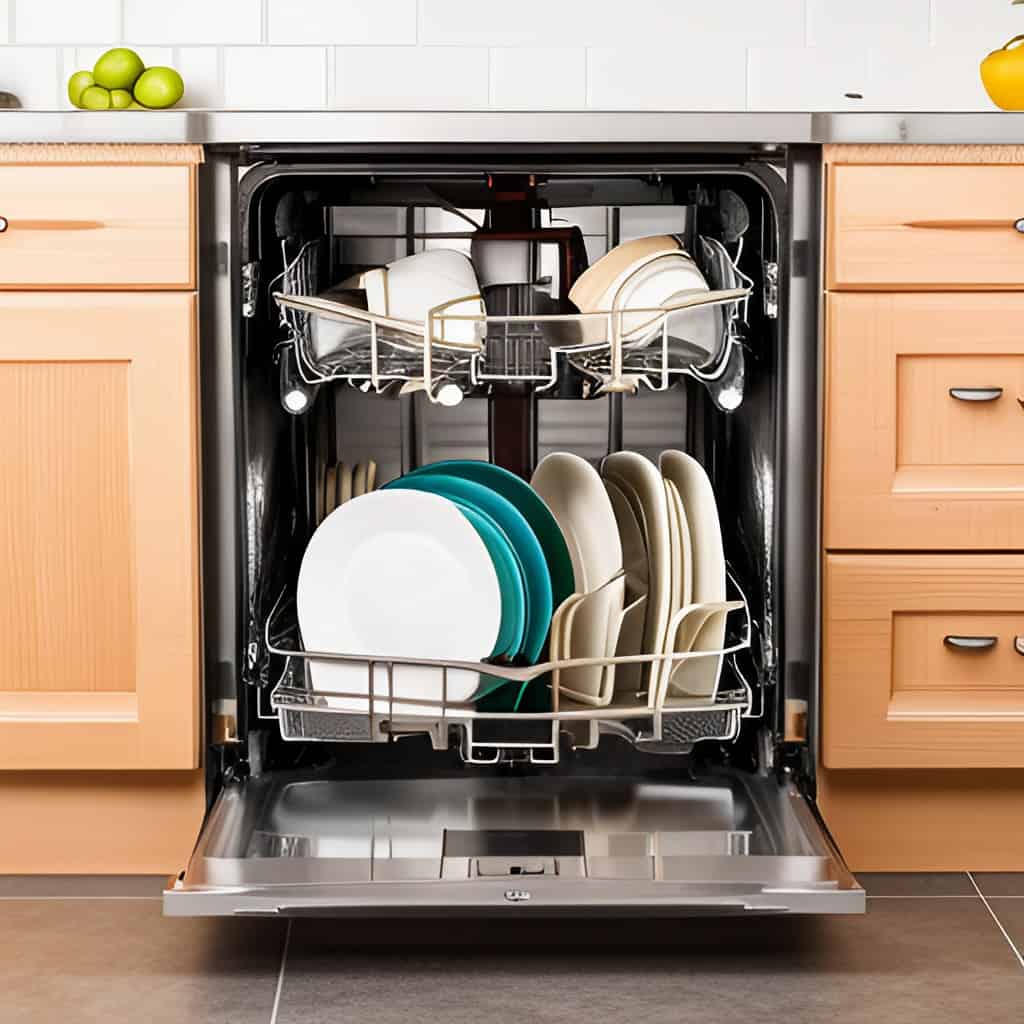How to Replace Dishwasher in 7 Simple Steps
A dishwasher is essential in modern homes, saving time and effort while ensuring our dishes are spotlessly clean. But what happens when your trusty dishwasher starts showing signs of wear and tear, or worse, stops functioning efficiently altogether? This comprehensive guide on how to replace dishwasher will walk you through the process in 7 simple steps, ensuring your kitchen remains the epitome of cleanliness and efficiency.
Key Takeaways
- Evaluate the need for replacement and take safety precautions before replacing a dishwasher.
- Gather necessary tools, consult manufacturer instructions, and remove the old dishwasher.
- Prepare space, install new appliance & test/troubleshoot to ensure successful installation.
When do you need to replace a dishwasher?

Understanding when to replace your dishwasher helps maintain your kitchen’s efficiency. Dishwashers typically have a lifespan of around ten years, but various signs may indicate it’s time for a replacement earlier than expected. Some common indications include:
- Unsatisfactory cleaning results
- Water leakage
- Accumulation of water in the base
- Door latch issues
- Rusting
- Peculiar noises
If you’ve already tried deep cleaning your dishwasher every 3-6 months and followed recommended loading procedures without success, it may be time to consider a new dishwasher.
Before proceeding with the replacement, ensure that a simple repair, like fixing a damaged flexible drain line causing water leakage, wouldn’t solve the issue. But, if the dishwasher’s performance keeps deteriorating, you should proceed with the replacement and relish the perks of a new, efficient appliance.
Evaluating the Need for Replacement

While contemplating dishwasher replacement, evaluating aspects like performance, energy consumption, and repair costs is pivotal. If the dishwasher’s performance is subpar and energy consumption is high, investing in a new dishwasher could result in long-term savings. Additionally, if the cost of repairing the existing dishwasher outweighs the benefits, a replacement is likely the best option.
For intricate dishwasher installations, like setting up an electrical outlet or plumbing, seeking professional assistance guarantees safe and successful installation. Remember that when replacing an old dishwasher, it’s best to use a new drain hose instead of reusing the old drain hose to prevent any drainage issues.
Safety Precautions and Preparation

Safety always comes first when dealing with appliances that require electrical and plumbing work. Taking the necessary precautions and preparing the installation area will ensure a smooth transition from the old dishwasher to the new one, ultimately saving you time and frustration.
Turn Off Water and Power Supplies
Before starting the dishwasher replacement, switching off the water and power supplies is imperative. The shut-off valve controlling the dishwasher’s water line can usually be found beneath the kitchen sink. It is connected to the hot water pipe or a two-way shutoff valve, which regulates water to the faucet and the dishwasher. To turn off the water supply, locate the shut-off valve and turn it clockwise (to the right) to fully close and shut off the water.
To disconnect the power supply to the dishwasher, follow these steps:
- Locate the cord providing power to the dishwasher.
- Unplug the cord from the wall outlet, typically located under the sink.
- If the dishwasher is hardwired, turn off the power at the circuit breaker for added safety.
Gather the Necessary Tools and Materials
For a successful dishwasher replacement, assemble the required tools and materials:
- Two adjustable wrenches
- A screwdriver
- A tape measure
- A pair of pliers
- A level
- A shallow pan
- A bucket
- A sponge
Having the right tools will make the job easier and help avoid unexpected complications during installation.
Consult Manufacturer’s Instructions
Before installing, consult the manufacturer’s instructions for your specific dishwasher model. Following the step-by-step guidelines will ensure a safe and successful installation, helping you avoid any unnecessary mishaps. Pay special attention to the instructions for connecting electrical wires and any other unique requirements for your dishwasher model.
Removing the Old Dishwasher

You can remove the old dishwasher after taking the necessary safety precautions and assembling the required tools. This involves:
- Disconnecting the water supply and drain lines
- Detaching the mounting brackets
- Adjusting the leveling legs
- Sliding the old dishwasher out for disposal.
Disconnect Water Supply and Drain Lines
Start by following these steps to disconnect your dishwasher:
- Close the valve on the water supply line.
- Unscrew the hose from the water supply valve. Have a bowl or bucket ready to catch any excess water that may leak from the disconnected hose.
- Disconnect the drain hose from the garbage disposal or sink drain.
- If your dishwasher uses an air gap, ensure it’s installed correctly in the new dishwasher to prevent drainage issues.
Remember that when installing a new dishwasher, using a new supply line instead of the old one is advisable. Steel-braided supply lines are highly recommended for their durability and longevity.
Detach Mounting Brackets and Adjust Leveling Legs
After disconnecting the water supply and drain lines, detach the mounting brackets by unscrewing the dishwasher. The mounting brackets are typically located beneath the lip of the kitchen counter. To adjust the leveling legs, use a wrench to loosen them, ensuring the dishwasher can slide out easily.
Once the mounting brackets and leveling legs are properly detached and adjusted, your old dishwasher can be removed from its cabinet space.
Slide Out and Dispose of the Old Dishwasher
Carefully slide the old dishwasher out of its cabinet using a dishwasher slide, and protect your flooring by placing a canvas drop cloth, cardboard, or towels on the floor during removal. Ensure the power cord, water supply tube, and drain hose passes through the appropriate holes as you slide the dishwasher out.
Once removed, properly dispose of the old dishwasher according to local regulations, or consider donating it if it’s still functional.
Preparing the Space for the New Dishwasher

With the removal of the old dishwasher, you can start preparing the installation space for the new one. Clean the area thoroughly, and make any necessary adjustments to cabinets or flooring to ensure a smooth and proper fit for the new appliance.
Before proceeding with the installation, measure the width, height, and depth of the cabinet space where the dishwasher will be installed to verify that the space meets the requirements for the selected dishwasher. Clear any interior shelves or obstacles that may hinder the installation and, if necessary, cut the cabinet to create space for the dishwasher, ensuring it reaches the floor.
Installing the New Dishwasher

With the area ready, you can proceed with the dishwasher installation. This involves connecting the water supply line, attaching the drain hose and power cord, and positioning and securing the new dishwasher.
Connect the Water Supply Line

Begin by connecting the copper water line to the dishwasher. Here’s how:
- Position the water supply line so it fits snuggly into the threaded section of the elbow joint.
- Ensure that the pipe is perfectly straight to ensure a secure connection. If you’re having difficulty getting a secure fit, try using a wrench to turn the elbow on the dishwasher slightly.
- Additionally, gently bend the copper line about eight to 12 inches from the end. Be careful not to over-tighten the connection, as this may cause damage.
Once the water supply line is connected, follow these steps to secure the 90-degree fitting to the back of the dishwasher:
- Attach the fitting to the back of the unit.
- Ensure the fitting is correctly aligned so the water supply line can extend parallel to the back of the dishwasher.
- Tighten the fitting securely to ensure a proper connection.
Attach Drain Hose and Power Cord
Attach the drain hose to the dishwasher pump. Make sure to tighten the clamp when you do this firmly. If your kitchen does not have a garbage disposal, connect the drain hose to the dishwasher tailpiece. Ensure the drain hose is properly secured to prevent leaks or drainage issues.
To install the power cord, follow these steps:
- Identify the wire connection housing and remove its cover.
- Thread the power cord through the wire connection housing.
- Connect the corresponding wires from the dishwasher to the power cord.
- Twist the wires together and attach a wire nut.
- Tighten the wire nut securely.
- Reattach the cover to the junction box.
- Thread the cord under the sink.
- Plug the power cord in.
Position and Secure the New Dishwasher
With the water supply line, drain hose, and power cord connected, carefully slide the new dishwasher into place under the kitchen counter, making sure the power cord, water supply tube, and drain hose are passed through the appropriate holes. Leave a space of about 1.5 to 2 inches between the back of the dishwasher and the countertop to facilitate proper heat flow.
Finally, use the appropriate mounting brackets or screws to attach the portable dishwasher to the countertop or cabinet, ensuring it is properly secured and in the ideal location for easy access to water hookups and dish storage.
Testing and Troubleshooting
After installing the new dishwasher, you need to test it for proper function and address any potential issues like leaks or improper drainage. Please turn on the water and power supplies and carefully observe the dishwasher for any signs of leaks or connection issues during its first cycle.
If you encounter leaks, work in small increments to tighten the connections without over-tightening, which may cause damage. If the dishwasher does not activate after restoring water and power, consider contacting a local electrician for assistance, especially if your home has aluminum wiring.

Summary
Replacing a dishwasher may seem daunting, but following this step-by-step guide can efficiently install a new dishwasher and enjoy the benefits of a clean, well-functioning kitchen. Don’t forget to consult the manufacturer’s instructions, take necessary safety precautions, and gather the proper tools and materials to ensure a smooth and successful installation. Now, relax, and let your new dishwasher do the dirty work!
Frequently Asked Questions
Can I replace the dishwasher myself?
You can replace a dishwasher yourself, although it requires handyman skills and some experience with electric wiring. However, once you have made the sizable purchase of a new dishwasher, there is no need to shell out more money for installation.
How long does it take to remove and install a dishwasher?
On average, it takes a professional about an hour to install a dishwasher, whereas a DIY job could take up to two or three hours, depending on experience. Make sure to buy a new inlet water connector as well.
How do I know when it’s time to replace my dishwasher?
If your dishwasher is over ten years old or showing signs of poor cleaning, leakage, door latch issues, or rusting, it’s time to consider replacing it.
What safety precautions should I take before installing a new dishwasher?
Before installing a new dishwasher, ensure a safe and smooth installation process by turning off the water and power supplies and gathering the necessary tools and materials.
How can I test my new dishwasher for proper function and troubleshoot any issues?
To test your new dishwasher, turn on the water and power supplies and observe it during its first cycle for any signs of leakage or connection issues. If any problems arise, carefully work to tighten connections without over-tightening.

